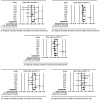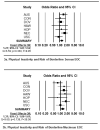Chronic Recreational Physical Inactivity and Epithelial Ovarian Cancer Risk: Evidence from the Ovarian Cancer Association Consortium
- PMID: 27197285
- PMCID: PMC4930728
- DOI: 10.1158/1055-9965.EPI-15-1330
Chronic Recreational Physical Inactivity and Epithelial Ovarian Cancer Risk: Evidence from the Ovarian Cancer Association Consortium
Abstract
Background: Despite a large body of literature evaluating the association between recreational physical activity and epithelial ovarian cancer (EOC) risk, the extant evidence is inconclusive, and little is known about the independent association between recreational physical inactivity and EOC risk. We conducted a pooled analysis of nine studies from the Ovarian Cancer Association Consortium to investigate the association between chronic recreational physical inactivity and EOC risk.
Methods: In accordance with the 2008 Physical Activity Guidelines for Americans, women reporting no regular, weekly recreational physical activity were classified as inactive. Multivariable logistic regression was utilized to estimate the ORs and 95% confidence intervals (CI) for the association between inactivity and EOC risk overall and by subgroups based upon histotype, menopausal status, race, and body mass index.
Results: The current analysis included data from 8,309 EOC patients and 12,612 controls. We observed a significant positive association between inactivity and EOC risk (OR = 1.34; 95% CI, 1.14-1.57), and similar associations were observed for each histotype.
Conclusions: In this large pooled analysis examining the association between recreational physical inactivity and EOC risk, we observed consistent evidence of an association between chronic inactivity and all EOC histotypes.
Impact: These data add to the growing body of evidence suggesting that inactivity is an independent risk factor for cancer. If the apparent association between inactivity and EOC risk is substantiated, additional work via targeted interventions should be pursued to characterize the dose of activity required to mitigate the risk of this highly fatal disease. Cancer Epidemiol Biomarkers Prev; 25(7); 1114-24. ©2016 AACR.
©2016 American Association for Cancer Research.
Figures



References
-
- Friedenreich CM, Neilson HK, Lynch BM. State of the epidemiological evidence on physical activity and cancer prevention. Eur J Cancer. 2010;46:2593–604. - PubMed
-
- Kruk J, Czerniak U. Physical activity and its relation to cancer risk: updating the evidence. Asian Pac J Cancer Prev. 2013;14:3993–4003. - PubMed
-
- WCRF/AICR Food, Nutrition, Physical Activity, and the Prevention of Ovarianc Cancer 2014 [electronic article] Continuous Update Project Report Ovarian Cancer 2014 Summary. Advance Access: June 23, 2014.
-
- USDHHS . 2008 Physical Activity Guidelines for Americans. Office of Disease Prevention and Health Promotion; Washington, D.C.: 2008.
Publication types
MeSH terms
Grants and funding
- UL1 TR001863/TR/NCATS NIH HHS/United States
- K22 CA138563/CA/NCI NIH HHS/United States
- R01 CA080742/CA/NCI NIH HHS/United States
- R01 CA074850/CA/NCI NIH HHS/United States
- P50 CA105009/CA/NCI NIH HHS/United States
- K07 CA080668/CA/NCI NIH HHS/United States
- P30 CA008748/CA/NCI NIH HHS/United States
- R01 CA188900/CA/NCI NIH HHS/United States
- R03 CA115195/CA/NCI NIH HHS/United States
- K01 LM012100/LM/NLM NIH HHS/United States
- P30 CA016359/CA/NCI NIH HHS/United States
- K07 CA095666/CA/NCI NIH HHS/United States
- R01 CA112523/CA/NCI NIH HHS/United States
- N01 PC067010/PC/NCI NIH HHS/United States
- P50 CA159981/CA/NCI NIH HHS/United States
- R25 CA113951/CA/NCI NIH HHS/United States
- R01 CA087538/CA/NCI NIH HHS/United States
- P30 CA046592/CA/NCI NIH HHS/United States
- P30 CA072720/CA/NCI NIH HHS/United States
- R01 CA095023/CA/NCI NIH HHS/United States
- R03 CA113148/CA/NCI NIH HHS/United States
- R01 CA058598/CA/NCI NIH HHS/United States
- P30 CA014089/CA/NCI NIH HHS/United States
- R01 CA083918/CA/NCI NIH HHS/United States
- R01 CA054419/CA/NCI NIH HHS/United States
- R01 CA122443/CA/NCI NIH HHS/United States
- P01 CA017054/CA/NCI NIH HHS/United States
- N01 CN025403/CA/NCI NIH HHS/United States
LinkOut - more resources
Full Text Sources
Other Literature Sources
Medical

